Solidarity Melts ICE: Stunning Dia de los Muertos Photos
Solidarity Melts ICE: Stunning Dia de los Muertos Photos
The celebration of Dia de los Muertos, or Day of the Dead, transcends mere festivities; it serves as a poignant reminder of cultural heritage and a platform for social justice. Recent events have shown that this traditional Mexican holiday has also become a powerful symbol of solidarity in the fight against Immigration and Customs Enforcement (ICE) policies. Various communities, particularly in the Bay Area, have harnessed the spirit of this vibrant holiday to express resilience and unity through stunning visual displays that capture the essence of a shared struggle.
Celebrating Heritage While Advocating Change
Dia de los Muertos is traditionally a time to honor deceased loved ones, with altars (ofrendas) adorned with photographs, food, and symbols rooted in personal and cultural significance. This year, however, many altars have taken on a more political tone. In many places throughout the Bay Area, these altars feature images and symbols that address the ongoing issues surrounding immigration and deportation.
According to a report from SFGate, many participants have used this year’s observances to vocalize their frustrations with ICE. One such event highlighted by the article involved community members creating altars that not only honored their ancestors but also memorialized individuals impacted by ICE enforcement. As a participant put it, “We’ve lost family members to deportation and violence.” This sentiment reflects a broader struggle affecting many communities, illustrating the intertwining of personal grief with social activism.
The Visual Power of Protest
The photographs emerging from these events serve more than just an aesthetic purpose; they function as a cultural commentary. Colorful decorations, marigolds, and skull imagery, traditional to Dia de los Muertos, juxtaposed with banners calling for justice against the backdrop of migration policies, create a deeply resonant visual narrative.
Mercury News reports that community members are inviting non-Latino neighbors to participate, extending the message of solidarity beyond their cultural lineage. As one organizer stated, “This isn’t just about our community; it’s about all those impacted by these policies.” Such inclusivity broadens the scope of understanding and fosters empathy, encouraging a collective approach to the issues at hand.
Photographs captured at these gatherings highlight more than just celebration; they portray defiance against the backdrop of despair. The vibrant colors and intricate designs often evoke joy, yet the underlying messages are steeped in a compelling narrative about struggles faced due to oppressive policies.
A Mixed Bag of Perspectives
While it is evident that many view Dia de los Muertos as a transformative space for protest and awareness, opinions are varied regarding this politicization of a sacred tradition. Some argue that integrating political messages into cultural celebrations may dilute their original meaning. Critics voice concern that the focus on social justice could overshadow the profound spiritual aspect of honoring the deceased.
Conversely, supporters contend that the very essence of Dia de los Muertos is rooted in remembrance and resilience, making it a fitting venue for advocacy. The blending of the two serves to not only honor the dead but also to agitate for a better tomorrow, reflecting the painful realities many families endure today.
Reports indicate that the intersections of tradition and change underscore a vital truth: the history of Dia de los Muertos is steeped in resilience and response to oppression. Rather than detracting from its sanctity, these expressions enhance its relevance in contemporary society.
Navigating Uncertainties
As events unfold, uncertainty remains regarding the broader implications of these cultural and political intersections. Will the politicization of Dia de los Muertos unify communities or further polarize them? Amidst voices calling for justice, the potential for conflict looms as differing views on the tradition’s focus emerge.
It’s crucial to recognize that these events reflect a microcosm of broader societal debates. Immigration is a profoundly complex issue, with perspectives varying widely across political, social, and cultural lines. The use of Dia de los Muertos as a platform for dialogue could foster understanding but also risks alienating those who may feel the tradition is being exploited for political ends.
Conclusion: Bridging Tradition and Activism
In summary, the stunning visuals of Dia de los Muertos celebrations serve as a testament to community resilience and solidarity against ICE’s policies. By melding color and culture with activism, participants are creating a space that honors the past while fighting for justice in the present. The dialogue surrounding the integration of political messages into such cultural observances is complex, and the future will inform whether this approach resonates or divides.
As communities gather to remember their ancestors, they are simultaneously championing a cause that extends beyond their own heritage. The ongoing conversation around these events will be crucial in shaping how culture and activism intersect going forward, making it an evolving narrative that is as beautiful as it is necessary.








